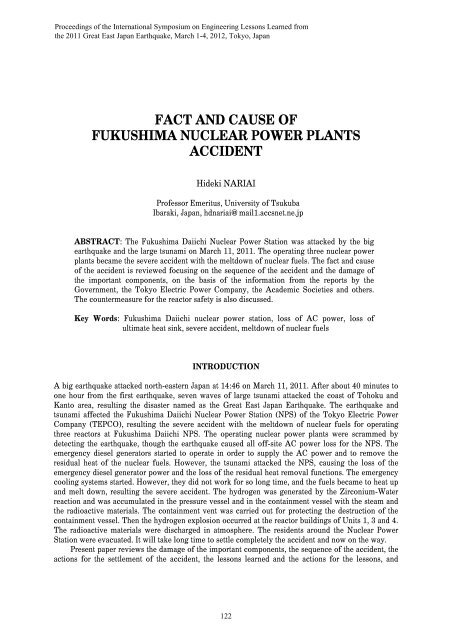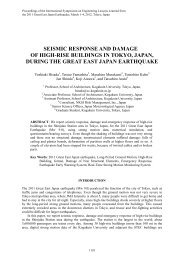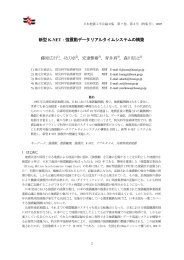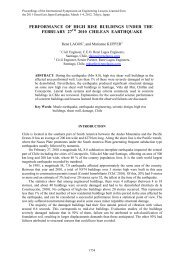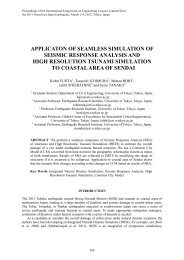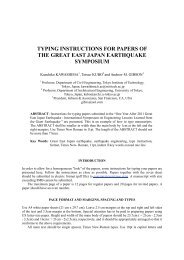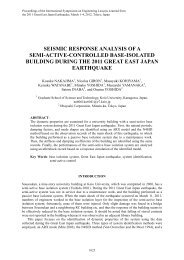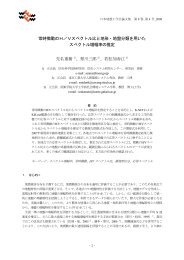Fact and Cause of Fukushima Nuclear Power Plants Accident
Fact and Cause of Fukushima Nuclear Power Plants Accident
Fact and Cause of Fukushima Nuclear Power Plants Accident
Create successful ePaper yourself
Turn your PDF publications into a flip-book with our unique Google optimized e-Paper software.
Companies introduced the Light Water Reactors (LWR) from USA. They were the Boiling WaterReactor (BWR) by General Electrics <strong>and</strong> the Pressurized Water Reactors (PWR) by Westinghouse.The first commercial BWR in Japan is Tsuruga NPS Unit 1 <strong>of</strong> JAPCO <strong>and</strong> started commercialoperation on March 1970. The first commercial PWR is Mihama NPS Unit 1 <strong>of</strong> Kansai Electric <strong>Power</strong>Company <strong>and</strong> started commercial operation on November 1970. These two plants were located at theFukui Prefecture, <strong>and</strong> a part <strong>of</strong> the electricity was transported to the Osaka Exposition in Osaka. Atpresent, 54 plants with 30 BWR <strong>and</strong> 24 PWR exist in Japan.All <strong>of</strong> the 6 nuclear power plants at <strong>Fukushima</strong> Daiichi NPS were BWR. The electric output,reactor model, pressure containment model <strong>and</strong> others were indicated in Table 1. The plants wereimproved as time passed. The Unit 1 is BWR 3 with 460 MW electric output <strong>and</strong> Mark-1 containmentvessel, though the Tsuruga Unit 1 is BWR 2 with 360 MW electric output <strong>and</strong> Mark-1 containmentvessel. The Units 2 to 5 are BWR4 with 784 MW electric output <strong>and</strong> Mark-1 containment vessel. TheUnit 6 is BWR 5 with 1100 MW electric output <strong>and</strong> Mark-2 containment vessel. The last Unit 6started commercial operation on October 1979. Figure 1 shows the main installation <strong>of</strong> Mark-1 typeBWR.Table 1 Specification <strong>of</strong> nuclear power plants at <strong>Fukushima</strong> Daiichi NPSPlant Number Unit 1 Unit 2 Unit 3 Unit 4 Unit 5 Unit 6Electric Output (MWe) 460 784 1100Commercial Operation 1971.03 1974.07 1976.03 1978.1 1978.04 1979.1Reactor Model BWR3 BWR4 BWR5Containment Vessel Model Mark-1 Mark-2Emergency Core Cooling SystemICHPCIRCICHPCSLPCSHPCS:High Pressure Core Spray System, LPCS:Low Pressure Core Spray SystemA Reactor buildingB Turbine building3 Crane4 <strong>Nuclear</strong> reactor1 Condenser 5 Drywell <strong>of</strong> containment vessel2 Turbine generator 6 Suppression chamber <strong>of</strong> containment vesselFig. 1 Installation <strong>of</strong> Mark-1 type BWR (Unit 2) (Hatamura 2011)124
Emergency cooling systems <strong>of</strong> Units 1, 2 <strong>and</strong> 3The emergency cooling systems were equipped in BWR providing for the cooling <strong>of</strong> nuclear fuels atthe accident. In Unit 1 (BWR 3), the Isolation Condenser (IC) <strong>and</strong> the High Pressure Coolant InjectionSystem (HPCI) were equipped. In Units 2 <strong>and</strong> 3 (BWR 4), the Reactor Core Isolation Cooling System(RCIC) <strong>and</strong> the HPCI were equipped. At the accident with the loss <strong>of</strong> normal fuel cooling function, theIC works to condense the steam in pressure vessel <strong>and</strong> to supply the generated water back in reactorvessel for the cooling <strong>of</strong> the nuclear fuels. Both the RCIC <strong>and</strong> the HPCI, which work by the steamdriven pump using the high pressure steam in pressure vessel, inject the water from the CondensateStorage Tank or from the Suppression Pool for the cooling <strong>of</strong> the fuels. They work without ACpower, though the DC power is required to operate the valves.Further, for the cooling <strong>of</strong> the reactor core under low pressure condition, the Core Spray System(CS) <strong>and</strong> the Shutdown Cooling System (SHC) were equipped for Unit 1, <strong>and</strong> the CS <strong>and</strong> theResidual Heat Removal System (RHR) were equipped for Units 2 <strong>and</strong> 3. However the AC power isneeded to operate them <strong>and</strong> they could not work at the accident.Plant status <strong>of</strong> the 6 plants before the earthquakeOn March 11, 2011, the three plants (Units 1, 2 <strong>and</strong> 3) were under operation, <strong>and</strong> the other three plants(Units 4, 5 <strong>and</strong> 6) were under shutdown for periodic inspection. The fuels <strong>of</strong> Unit 4 were transferred tothe spent fuel pool since exchange <strong>of</strong> the shroud was underway during the periodic inspection. Thefuels <strong>of</strong> Units 5 <strong>and</strong> 6 were in the pressure vessel.OCCURENCE OF THE EARTHQUAKEAt 14:46 on March 11, 2011, the big earthquake occurred at north-eastern Japan. The earthquake waswith the scale <strong>of</strong> moment magnitude 9.0, fourth largest earthquake ever recorded in the world history.The earthquake occurred as the result <strong>of</strong> faulting on the boundary between the Pacific Plate <strong>and</strong> NorthAmerican Plate. The epicenter was about 130 km southeast <strong>of</strong> Oshika Peninsula with a depth <strong>of</strong>approximately 24 km. The size <strong>of</strong> the faulting zone was about 400 km long, <strong>and</strong> approximately 200km wide. Figure 2 shows the epicenter <strong>of</strong> the earthquake <strong>and</strong> the location <strong>of</strong> the 5 nuclear powerstations in the afflicted area <strong>of</strong> the disaster.<strong>Nuclear</strong> power plants at the afflicted areaIn the afflicted area <strong>of</strong> the disaster, 15 BWR plants have been constructed. They are from the north, 1plant at the Higasidori NPS <strong>of</strong> Tohoku Electric <strong>Power</strong> Co., 3 plants at the Onagawa NPS <strong>of</strong> TohokuElectric <strong>Power</strong> Co., 6 plants at the <strong>Fukushima</strong> Daiichi NPS <strong>of</strong> TEPCO, 4 plants at the <strong>Fukushima</strong>Daini NPS <strong>of</strong> TEPCO, <strong>and</strong> 1 plant at the Tokai Daini NPS <strong>of</strong> JAPCO. Most <strong>of</strong> the plants have beenbrought to the cold shutdown condition within several days. However, the tsunami caused the reactoraccident with the meltdown <strong>of</strong> fuels for three plants at the <strong>Fukushima</strong> Daiichi NPS.Affect <strong>of</strong> the earthquake on the <strong>Fukushima</strong> Daiichi NPSThe three operating plants (Units 1, 2 <strong>and</strong> 3) were shut down automatically by detecting theearthquake at 14:46 on March 11. However, all external electric power for Units 1 to 6 was lost by theearthquake. Then emergency diesel power generators started <strong>and</strong> the decay heat <strong>of</strong> nuclear fuels wasremoved by the cooling system until the tsunami attack. The emergency cooling systems startedautomatically or manually. They were the IC for Unit 1 <strong>and</strong> the RCIC for Units 2 <strong>and</strong> 3.125
Fig. 2Epicenter <strong>of</strong> the Earthquake <strong>and</strong> the location <strong>of</strong> five nuclear power stations<strong>Cause</strong> <strong>of</strong> the external AC power loss at <strong>Fukushima</strong> Daiichi NPSNow the cause <strong>of</strong> the external (<strong>of</strong>f-site) AC power loss will be explained. The electric power wassupplied through 6 lines for Units 1 to 6. For Units 1 <strong>and</strong> 2, the electricity was transmitted fromShin-<strong>Fukushima</strong> Transforming Station through Okuma Nos. 1 & 2 lines to the normal high voltageswitchboard <strong>of</strong> Units 1 <strong>and</strong> 2 via the switchyards for Units 1 <strong>and</strong> 2. Further TEPCO nuclear line fromTohoku Electric <strong>Power</strong> Co. connected as a reserve to the normal high voltage switchboard <strong>of</strong> Unit 1.Due to the earthquake, several parts <strong>of</strong> the circuit breakers at the switchyards for Units 1 <strong>and</strong> 2 weredamaged, resulting the actuation <strong>of</strong> the circuit breakers at the Shin-<strong>Fukushima</strong> Transforming Station.As for the TEPCO nuclear line, the connecting cables to metal-clad switch gear <strong>of</strong> Unit 1 weredamaged <strong>and</strong> failed. As for Units 3 <strong>and</strong> 4, the Okuma Nos. 3 <strong>and</strong> 4 lines connected to the normalhigh voltage switchboard <strong>of</strong> Units 3 <strong>and</strong> 4. The line cables touched the tower, resulting the shortcircuit <strong>and</strong> failed. Further the normal high voltage switchboard was inundated later. These resulted theactuation <strong>of</strong> the circuit breakers at the Shin-<strong>Fukushima</strong> Transforming Station. As for Units 5 <strong>and</strong> 6, theYonomori Nos. 1 <strong>and</strong> 2 transmission lines connected to the normal high voltage switchboard <strong>of</strong> Units5 <strong>and</strong> 6. By the earthquake, the line cables touched each other, resulting the actuation <strong>of</strong> the circuitbreakers at the Shin-<strong>Fukushima</strong> Transforming Station. Further one tower <strong>of</strong> transmission lineconnecting to the switchyards for Units 5 <strong>and</strong> 6 was collapsed. These resulted the loss <strong>of</strong> all external(<strong>of</strong>f-site) power supplies to Units 1 to 6.ATTACK BY THE TSUNAMIAt about 40 minutes to one hour later <strong>of</strong> the first earthquake, seven waves <strong>of</strong> large tsunami attackedthe coast <strong>of</strong> Tohoku-Kanto area. At the <strong>Fukushima</strong> Daiichi NPS, the first wave <strong>of</strong> tsunami reached at15:27, <strong>and</strong> the second large tsunami at 15:35 on March 11. The tsunami with 15 m high was gettingover the 10 m high sea wall <strong>and</strong> entered into the reactor <strong>and</strong> turbine buildings area. The cooling seawater pumps at the sea side with 4.1 m high were inundated. The emergency diesel power generators,126
metal-clad switch gear, power center, <strong>and</strong> so on at the lower level <strong>of</strong> the turbine buildings were alsoinundated.Function loss <strong>of</strong> major machines <strong>and</strong> componentsEmergency diesel power generatorsThe number <strong>of</strong> emergency diesel power generators (DG) at <strong>Fukushima</strong> Daiichi NPS were 13. Theysupply the power to each Unit through matal-clad switch gear (M/C). Each Unit had 2 (A <strong>and</strong> B) DGexcept Unit 6 which had 3. Among them, 10 DG were sea water cooled <strong>and</strong> 3 DG (Unit 2B, Unit 4B<strong>and</strong> Unit 6B) were air cooled. By the tsunami attack, all sea water cooled DG lost the function, though3 air cooled alive. For Unit 1, DG 1A <strong>and</strong> 1B located at the first basement <strong>of</strong> the turbine building(T/B) inundated <strong>and</strong> lost the function. For Unit 2, DG 2A located at the first basement <strong>of</strong> T/Binundated <strong>and</strong> lost the function. DG 2B located at the first floor <strong>of</strong> the common spent fuel poolbuilding was alive, though the M/C inundated <strong>and</strong> the function was lost. For Unit 3, DG 3A <strong>and</strong> 3Blocated at the first basement <strong>of</strong> T/B was inundated <strong>and</strong> lost the function. For Unit 4, DG 4A was underperiodic inspection. DG 4B located at the first floor <strong>of</strong> the common spent fuel pool building was alive,though the M/C inundated <strong>and</strong> the function was lost. For Unit 5, DG 5A <strong>and</strong> 5B located at the firstbasement <strong>of</strong> T/B was alive, though the connected components inundated <strong>and</strong> the function was lost. ForUnit 6, DG 6A <strong>and</strong> DG 6C located at the first basement <strong>of</strong> the reactor building was alive, though thesea water pump necessary to cool the DG was inundated <strong>and</strong> the function was lost. DG 6B located atthe first floor <strong>of</strong> diesel generator building was alive <strong>and</strong> the function to supply power was alive.Metal-clad switch gear (M/C) <strong>and</strong> power center (P/C)M/C is the 6900 V switch board for high voltage circuit power, <strong>and</strong> P/C is the 480V switch board forlow voltage circuit power. Number <strong>of</strong> the M/C <strong>and</strong> the P/C was 15 each. They are three kinds such asfor normal operation, for emergency <strong>and</strong> for common. Due to the earthquake, the M/C <strong>and</strong> the P/C fornormal <strong>and</strong> for common were lost the function since the external power was lost. By the tsunami, 12among 15 M/C for emergency were inundated <strong>and</strong> lost the function, <strong>and</strong> 9 among 15 P/C foremergency were inundated <strong>and</strong> lost the function.Emergency cooling sea water pumpThe emergency cooling sea water pumps are equipped to supply the sea water to the heat exchanger <strong>of</strong>Containment Cooling System (CCS) for Unit 1 <strong>and</strong> Residual Heat Removal System (RHR) for Units 2to 6. After the tsunami attack, the emergency cooling sea water pump stopped by the loss <strong>of</strong> AC power<strong>of</strong> Units 1 to 5, <strong>and</strong> the function <strong>of</strong> the CCS <strong>and</strong> the RHR was lost.Outline <strong>of</strong> the sequenceACCIDENT SEQUENCE OF UNITS 1 TO 6The operating Units 1, 2 <strong>and</strong> 3 were scrammed by detecting the earthquake. Since the external ACpower was lost, emergency DG started to work for cooling the nuclear fuels. The emergency coolingsystems, such as the IC for Unit 1 <strong>and</strong> the RCIC for Units 2 <strong>and</strong> 3, started.However, about 50 minutes later, all the emergency DG stopped, resulting all AC power loss. Allultimate heat sink were also lost. The emergency cooling systems were only way to cool the nuclearfuels, though control <strong>of</strong> the systems should be done by DC battery with short life time. During the fuelcooling, recovery <strong>of</strong> the ultimate heat sink should urgently be done. However, the aftershock, thetsunami remnants <strong>and</strong> the destroyed road by the earthquake prevented the work to recover the situationfrom the outside. The batteries did not work for so many days, though operators did the best to prolongthe batteries' life time. Finally heat-up <strong>and</strong> melt-down <strong>of</strong> the fuels occurred <strong>and</strong> the severe accidentresulted in Units 1, 2 <strong>and</strong> 3.Units 4, 5 <strong>and</strong> 6 were in periodic inspection outage. Unit 4 was on the way to replace the reactor127
core shroud <strong>and</strong> all fuel assemblies had been transferred to the spent fuel pool. As for Unit 5, all fuelassemblies was loaded in the reactor core <strong>and</strong> the pressure leak test for reactor pressure vessel wasbeing conducted. As for Unit 6, all fuel assemblies were loaded in the reactor core that was in coldshutdown condition.Sequence <strong>of</strong> the Unit 1Unit 1 reactor was scrammed by detecting the earthquake, <strong>and</strong> two emergency DGs started. The twoICs automatically started to cool the fuels. However, the cooling speed was too fast compared with theoperation manual, <strong>and</strong> operators stopped it manually. After then, one IC was used to cool the fuels.The cooling <strong>and</strong> the stop <strong>of</strong> the IC was repeated 3 times. The tsunami attacked the NPS at 15:35 <strong>and</strong>the emergency DGs <strong>and</strong> the ultimate heat sink were lost. The IC was stopped when the tsunamiattacked. Then the cooling water could not be supplied to the reactor core, <strong>and</strong> the water in thepressure vessel began to decrease. The fuels could not be cooled when the water level decreased belowthe fuel level, resulting the heat-up <strong>of</strong> the fuels. The cladding material <strong>of</strong> the fuel is zircaloy orzirconium alloy, <strong>and</strong> the zirconium begins to react severely with water (or steam) at above 900 °C,generating the hydrogen <strong>and</strong> the zirconium oxide. The reaction is the exothermic reaction <strong>and</strong> thereaction rate increases rapidly above 1200 °C, resulting the increase <strong>of</strong> the fuel temperature. Thus alarge amount <strong>of</strong> the hydrogen generated <strong>and</strong> the fuel temperature increased more than the meltingtemperature <strong>of</strong> the zircaloy <strong>and</strong> reached the melting temperature <strong>of</strong> the fuels.Since all <strong>of</strong> the equipped cooling functions were lost, cooling <strong>of</strong> the fuels by injection <strong>of</strong> waterfrom outside was necessary. Injection <strong>of</strong> water through the fire protection system into the pressurevessel by using the fire engine began in the morning on March 12. However, it was too late to cool thefuels. Damage <strong>of</strong> the fuels began at the evening on March 11, almost 4 hours from the tsunami attack.Considerable amount <strong>of</strong> the damaged fuels moved to <strong>and</strong> accumulated at the bottom <strong>of</strong> the reactorpressure vessel. The pressure vessel was damaged at about 10 hours from the tsunami attack <strong>and</strong>pressure in the pressure vessel dropped largely. Then the pressure <strong>and</strong> the temperature in thecontainment vessel began to increase to the highest pressure at 2:30 on March 12. In order to preventthe rupture <strong>of</strong> containment vessel, wet well venting from the containment vessel was carried out twiceat 10:17 <strong>and</strong> 14:30 on March 12. After the second venting, a hydrogen explosion occurred in thereactor building <strong>of</strong> Unit 1, destroying the upper floor <strong>of</strong> the reactor building at 15:36 on March 12, just24 hours later <strong>of</strong> the tsunami attack. After the hydrogen explosion, sea water injection into the pressurevessel was again started at 19:04. However, some <strong>of</strong> the molten fuels may have dropped on the lowerplenum <strong>of</strong> the pressure vessel on around 20 March, <strong>and</strong> further they dropped <strong>and</strong> accumulated on thepedestal <strong>of</strong> the drywell floor <strong>of</strong> containment vessel, at almost the end <strong>of</strong> March. The moltencore-concrete reaction may have occurred there.Sequence <strong>of</strong> the Unit 2Unit 2 reactor was also scrammed by detecting the earthquake, <strong>and</strong> two emergency DGs started. TheRCIC was also started manually. After the loss <strong>of</strong> both emergency DG <strong>and</strong> ultimate heat sink by thetsunami attack, the RCIC was alive for 3 days until at 13:25 on March 14. The operators conducted thefeed <strong>and</strong> bleed operation, that is, the water was fed into reactor by the RCIC, then the steam pressurerose. The steam was bled through the safety relief valve into the water pool in the suppressionchamber. Water temperature <strong>of</strong> suppression pool increased to almost saturation temperature <strong>and</strong>gradually steam could not be condensed. The leakage was estimated to occur probably around thesuppression chamber <strong>of</strong> containment vessel before noon on March 14. After 6 <strong>and</strong> half an hour laterfrom the RCIC stop, sea water was injected into the pressure vessel. During the no cooling period,however, the fuels were exposed to steam <strong>and</strong> started melting at around 16:30 on March 14, <strong>and</strong>molten fuels dropped to lower plenum <strong>of</strong> the pressure vessel. Further the lower part <strong>of</strong> the pressurevessel was damaged at around 21:30 <strong>and</strong> some <strong>of</strong> the molten fuel dropped on the pedestal <strong>of</strong> thecontainment vessel before 24:00 on March 14. The drop <strong>of</strong> the molten fuel on the pedestal <strong>of</strong>containment vessel was continued for a while. The containment vent was already prepared on March13, but it was not carried out. Noise <strong>of</strong> an explosion occurred at around 6:00 on March 15. There is apossibility that any explosion occurred around the torus room <strong>of</strong> the containment vessel. However128
TEPCO reported that the noise might be the sound <strong>of</strong> the explosion just occurred at Unit 4 at that time.Sequence <strong>of</strong> the Unit 3Unit 3 reactor was also scrammed by detecting the earthquake, <strong>and</strong> the power was supplied by theemergency diesel power generators. The RCIC was manually controlled. After the tsunami attack, theRCIC was started manually at 16:03 on March 11, since the DC batteries were alive. However theRCIC stopped at 11:36 on March 12. After one hour's later, the HPCI started automatically bydetecting the low water level to continue the cooling <strong>of</strong> the fuels. The operators stopped the HPCI at2:42 on March 13, since they intended to save the consumption <strong>of</strong> the batteries. However they couldnot start the HPCI again, since the batteries were already consumed. The steam relief valve was opento decrease rapidly the pressure in pressure vessel at 9:08 <strong>and</strong> the water was injected through fireprotection system at 9:25 on March 13. During the no cooling period, the fuels exposed <strong>and</strong> startedmelting at around 8:00 on March 13. At around 9:00 on March 13, the upper flange gasket <strong>of</strong>containment drywell was estimated to be damaged. At the same time the lower part in pressure vesselwas damaged, <strong>and</strong> the molten core dropped on the pedestal floor <strong>of</strong> the containment vessel. The ventfrom the containment vessel was carried out several times at 9:20, at 12:30 on March 13 <strong>and</strong> at 5:20 onMarch 14. A hydrogen explosion occurred in the reactor building at 11:02 on March 14, destroying thereactor building.Sequence <strong>of</strong> the Unit 4Unit 4 reactor had been shut down for periodic inspection, with the nuclear fuels having beentransferred to the spent fuel pool. Both the cooling <strong>and</strong> the water feeding functions for the spent fuelpool were lost by the earthquake <strong>and</strong> the tsunami. Temperature <strong>of</strong> the spent fuel pool rose to 84 °C at4:08 on March 14. At about 6:00 on March 15, an explosion in the reactor building occurred, <strong>and</strong>destroyed the upper part <strong>of</strong> the building. At first, the cause <strong>of</strong> the explosion attributed to the hydrogengenerated by the over-heating <strong>and</strong> melting <strong>of</strong> the fuels in the pool. Injection <strong>of</strong> water to the pool wasconducted from the helicopter, <strong>and</strong> by the water discharge car. However it was confirmed that theenough water existed in the spent fuel pool. As the cause <strong>of</strong> the explosion, an inflow <strong>of</strong> hydrogen fromUnit 3 is possible, since the exhaust pipe for venting, joins with the exhaust pipe from Unit 4 beforethe exhaust stack.Sequence <strong>of</strong> the Units 5 & 6Unit 5 was in periodic inspection outage. At the accident, all fuel assemblies were loaded in thereactor core <strong>and</strong> the pressure leak test for reactor pressure vessel was being conducted. By the tsunamiattack, all the AC power supply was lost, resulting the loss <strong>of</strong> the ultimate heat sink. As the coolingfunction was lost, the reactor pressure continued to increase. The water level <strong>and</strong> the pressure wasmaintained by injecting water into the reactor by operating the make-up condensing water pump afterthe power was supplied from Unit 6. The water in the spent fuel pool was also supplied. On March 19,a temporary seawater pump was activated to operate the RHR, bringing the reactor to a cold shutdowncondition at 14:30 on March 20.Unit 6 was in periodic inspection outage. At the accident, all fuel assemblies were loaded in thereactor core that was in cold shutdown condition. One <strong>of</strong> the emergency DGs for Unit 6 had beeninstalled at a relatively high location, <strong>and</strong> its functions were not lost after the tsunami attack. However,the sea water pump lost its function. The reactor water level <strong>and</strong> the pressure was controlled byinjecting water into the reactor by operating the make-up condensing water pump. A temporaryseawater pump was activated to operate the RHR on March 19, bringing the reactor to a coldshutdown condition at 19:27 on March 20.Cooling <strong>of</strong> the reactors <strong>and</strong> spent fuel poolThe residual heat from the nuclear fuels for damaged Units 1 to 3 reactors, for Units 5 <strong>and</strong> 6 reactorsunder outage, <strong>and</strong> for spent fuel pools <strong>of</strong> Units 1 to 6 should continuously be removed. Particularly thedamaged molten fuels in reactors <strong>and</strong> in containment vessels in Units 1 to 3 should be cooled by129
RELEASE OF RADIOACTIVE MATERIALS AND EVACUATION OF THE RESIDENTSRelease <strong>of</strong> the radioactive materialsThe radiation dose rate around the <strong>Fukushima</strong> Daiichi NPS increased many times within the first 2weeks after the occurrence <strong>of</strong> the accident. This indicates that the radioactive materials released inatmosphere. The release <strong>of</strong> the radioactive materials were mainly by the venting from the containmentvessel, by the explosion <strong>of</strong> the reactor buildings, <strong>and</strong> also by the leak through the damaged opening <strong>of</strong>the containment vessel just after the operation <strong>of</strong> the safety relief valve or after the water injectionover the hot damaged fuels. The radiation dose rate decreased gradually after the end <strong>of</strong> March. Figure4 shows the change <strong>of</strong> the radiation dose rate at the NPS with the estimated causes <strong>of</strong> the increase(METI 2011).Fig. 4 Changes in dose rates at <strong>Fukushima</strong> Daiichi (Monitoring car) (METI 2011)The radiation dose rate at the NPS started to increase at around 4:00 on March 12. This mayindicate any damage <strong>of</strong> the reactor pressure vessel <strong>and</strong> containment vessel in Unit 1, since the drywellpressure <strong>of</strong> Unit 1 started to increase rapidly at around 1:00 on March 12. The radiation dose rateincreased further by the wetwell venting at 10:17 <strong>and</strong> at 14:30 on March 12, <strong>and</strong> also by the leakthrough any damaged part at lower location <strong>of</strong> the containment vessel. Radiation dose rate furtherincreased at around 20:00 on March 12. This may be due to the generation <strong>of</strong> large amount <strong>of</strong> steam,hydrogen, <strong>and</strong> radioactive materials by the sea water injection into the reactor pressure vessel at 19:04on March 12.In order to decrease the pressure in pressure vessel <strong>of</strong> Unit 2 after the stop <strong>of</strong> the RCIC, theoperator opened the safety relief valve at around 18:00 on March 14. Then the steam, hydrogen <strong>and</strong>radioactive materials in pressure vessel moved to the suppression pool. As any damage may exist atthe suppression chamber, as explained in sequence <strong>of</strong> the Unit 2, the radioactive materials leaked fromsuppression chamber to outside. This increased the radiation dose rate at around 22:00 on March 14.After the noise <strong>of</strong> explosion at around 6:00 on March 15, the radiation dose rate increased at the NPS.If the hydrogen explosion occurred at around the torus room <strong>and</strong> made any crack there, then theradioactive materials may be discharged into atmosphere through the crack. The radiation dose rateincreased at around morning to noon <strong>of</strong> March 15. This corresponds to the time that the damaged core131
dropped to the lower plenum in pressure vessel <strong>of</strong> Unit 2.The radiation dose rate was increased at around 9:00 on March 13. This is estimated that theradioactive materials leaked through the damaged flange gasket at the upper part <strong>of</strong> the drywell in Unit3, by the wetwell venting from containment vessel <strong>and</strong> also by the sea water injection into pressurevessel. On March 16, several very high radiation dose rates were measured, which are estimated to beby the wetwell venting. The reason is that the suppression chamber became full <strong>of</strong> the water injectedfrom outside at that time, <strong>and</strong> the wetwell venting resulted the release <strong>of</strong> the highly contaminatedwater <strong>and</strong> steam directly into atmosphere.Evacuation <strong>of</strong> the residentsTEPCO recognized that the injection <strong>of</strong> water via the emergency core cooling system was not certainat Units 1 <strong>and</strong> 2, <strong>and</strong> notified the Government <strong>of</strong> the state <strong>of</strong> <strong>Nuclear</strong> Emergency at the evening onMarch 11. The Prime Minister declared a state <strong>of</strong> nuclear emergency, <strong>and</strong> established the <strong>Nuclear</strong>Emergency Response Headquarters <strong>and</strong> the local <strong>Nuclear</strong> Emergency Response Headquarters. ThePrime Minister instructed to evacuate the residents within 3 km radius from NPS, <strong>and</strong> to stay in housewithin 10 km at 21:30 on March 11. According to the escalation <strong>of</strong> the events, the evacuation area wasexp<strong>and</strong>ed to evacuate the residents within 10 km at 5:44 on March 12 <strong>and</strong> within 20 km at 18:25 fromNPS. The area to stay in house was also set as within 20 to 30 km on March 15.On April, the government changed the area <strong>and</strong> settled the restricted area within 20 km from theNPS. The deliberate evacuation area <strong>and</strong> the emergency evacuation preparation area were newlysettled beyond 20 km from NPS. The deliberate evacuation area is the area in which the accumulateddose may reach 20 mSv in one year. Figure 5 shows the integrated dose in one year after the accident(METI 2011). The high dose area exp<strong>and</strong>s to the north-west direction <strong>of</strong> the NPS which was reflectingthe wind direction <strong>and</strong> the rain fall at the day that the radioactive materials discharged. In restrictedarea, the residents can temporarily access to their home.[Unit: mSv] 30 km line 20 km lineFig. 5 Estimated Integrated dose for one year up to March 11, 2012 (METI 2011)132
ACTIONS FOR THE SETTLEMENT OF THE ACCIDENT AND TOWARDSTHE DECOMMISSIONING OF THE DAMAGED REACTORSActions for the settlement <strong>of</strong> the accidentTEPCO announced the “Roadmap towards Restoration from the accident in <strong>Fukushima</strong> Daiichi<strong>Nuclear</strong> <strong>Power</strong> Station” on April 17. The basic policy was for the reactors <strong>and</strong> the spent fuel pools tobe stable condition, <strong>and</strong> for the release <strong>of</strong> radioactive materials to be mitigating. Further every effortshould be done for evacuees to return to their home <strong>and</strong> for all citizens to secure a sound life. Twosteps were set as the target, as step 1 with the time line target <strong>of</strong> 3 months <strong>and</strong> step 2 with the time linetarget <strong>of</strong> 3 to 6 months after achieving step 1. The target <strong>of</strong> the step 1 was the radiation dose in steadydecline <strong>and</strong> that <strong>of</strong> step 2 was the release <strong>of</strong> radioactive materials under control <strong>and</strong> radiation dosebeing significantly held down. TEPCO announced the accomplishment <strong>of</strong> the step 1 target on July 19<strong>and</strong> that <strong>of</strong> the step 2 target on December 16, 2011. After the accomplishment <strong>of</strong> the step 2 target, themiddle <strong>and</strong> long term Roadmap towards the decommissioning <strong>of</strong> the four damaged reactors should bemade <strong>and</strong> now on the way.Activities during Step 1The major items conducted during the step 1 were (1) the continuous fuel cooling by minimum waterinjection, (2) the transfer <strong>of</strong> accumulated water in the basement <strong>of</strong> the turbine buildings into temporarytanks <strong>and</strong> the installation <strong>of</strong> the circulation type water purification system, <strong>and</strong> (3) the design <strong>of</strong> thecover for destroyed reactor buildings.The water was continuously injected in order to cool the reactor core <strong>of</strong> Units 1, 2 <strong>and</strong> 3. Largeamount <strong>of</strong> water was injected into the reactor core, though it was leaking outside <strong>of</strong> the containmentvessel. The leaked water accumulated in the reactor buildings <strong>and</strong> turbine buildings. The circulationtype water purification facility was designed in order to reuse the decontaminated water for thecooling <strong>of</strong> the reactor core. The cover for the destroyed reactor building was also very important fordecreasing the release <strong>of</strong> radioactive materials.During the step 1, the temperature at the bottom <strong>of</strong> reactor pressure vessel decreased to 100 °C120 °C, <strong>and</strong> the radiation dose rate decreased to 1.7 mSv/y at the site boundary.Activities during Step 2The major items conducted during the step 2 were the continuation <strong>of</strong> the step 1. The first is thereactor cooling by the circulating injection cooling along with the treatment <strong>of</strong> high level radioactivewaste water. The operation started on June 27. The second was the spent fuel cooling using the heatexchanger. The third was the mitigation <strong>of</strong> contamination in the sea through the underground water.Design <strong>of</strong> the ground water shielding wall started. The fourth was the installation <strong>of</strong> the cover over thehighly damaged reactor buildings, in order to prevent further release <strong>of</strong> the radioactive materials. Thecover <strong>of</strong> Unit 1 was completed at the end <strong>of</strong> October 2011. The construction <strong>of</strong> the cover for Units 3<strong>and</strong> 4 has been on the way.During the step 2, the temperature at the bottom <strong>of</strong> the reactor pressure vessel decreasedsufficiently below 100 °C, <strong>and</strong> the reactors were brought to a condition equivalent to the coldshutdown. The radiation dose rate decreased to 0.1 mSv/y at the site boundary. Basing on these data,TEPCO announced the accomplishment <strong>of</strong> the step 2 on December 16, 2011 (TEPCO 2011).Activities towards the middle <strong>and</strong> long term roadmap for the decommissioning <strong>of</strong> the reactorsAfter the completion <strong>of</strong> the step 2, the roadmap towards the decommissioning <strong>of</strong> Units 1 to 4 has to bemade, including the implementation <strong>of</strong> the on-site work <strong>and</strong> the R&D towards the decommissioningsuch as the removal <strong>of</strong> fuels from the spent fuel pools. Now the middle term activities for 3 yearsuntil the start <strong>of</strong> the work for decommissioning has started.133
LESSONS LEARNED AND ACTIONSFOR THE RECONSTRUCTION OF NECLEAR REACTOR SAFETYLessons learned <strong>and</strong> actionsThe Japanese Government indicated the lessons learned from the accident in the report to the IAEAMinisterial Conference on <strong>Nuclear</strong> Safety on July 2011. Lessons were in 5 categories with 28 items.Further the Japanese Government presented the additional report to the IAEA on September 2011, inwhich the actions for the lessons were explained. The major items relating directly to the cause <strong>of</strong> theaccident <strong>and</strong> the actions by the Japanese Government will be explained. Further the activities by theAtomic Energy Society <strong>of</strong> Japan, the JANTI <strong>and</strong> the TEPCO will shortly be explained.Lessons learned in Japanese Government reportAmong five categories in Japanese government report, major items in three categories which aredirectly relevant to the cause <strong>of</strong> the accident will be explained. The first category <strong>of</strong> the lessonslearned is to strengthen preventive measures against severe accident. This requires for the reactors toavoid the severe accident under various kinds <strong>of</strong> big natural disaster, such as earthquake <strong>and</strong> tsunami.The reactors <strong>and</strong> important equipments were not damaged by the big earthquake <strong>of</strong> this accident.However, <strong>of</strong>f-site electric power supply system was damaged by the earthquake. For tsunami, thewave height estimated before was not enough to prevent the accident. The current guideline indicatesthe 30 min. loss <strong>of</strong> AC power. In this disaster, some plants were safely shut down since a part <strong>of</strong>power supply system was alive <strong>and</strong> the sea water pump was recovered for the RHR. The considerationfor the longer loss <strong>of</strong> AC power supply was necessary for the reconstruction <strong>of</strong> the nuclear safety, <strong>and</strong>it should be included in the safety design guidelines. The loss <strong>of</strong> emergency DG should also properlybe considered. As for the accident management, the alternative water injection system was notsufficient under no power source <strong>and</strong> high radiation environment.The second category is the enhancement <strong>of</strong> response measures against severe accidents. As forthe hydrogen explosion, the explosion inside the containment vessel was mainly considered forproviding the countermeasures. Hydrogen explosion outside the containment vessel should also beconsidered. The containment venting system should much be enhanced. Further the radiation dosebecame very high in the main control room <strong>and</strong> the operators could not enter the room temporarily.The environment for the accident response work should be improved.The fourth category is the reinforcement <strong>of</strong> safety infrastructure. This is to enforce the safetyregulatory bodies, legal structures, criteria <strong>and</strong> guidelines <strong>and</strong> human resources. Several subjects suchas the use <strong>of</strong> PSA in government examination <strong>and</strong> such as the consideration <strong>of</strong> severe accident in theregulatory matter were retarded in Japan. Further the severe accident research should be promotedmuch more.Actions by the GovernmentAccording to the lessons, the Government started the investigation for several items. The first is theComprehensive Safety Evaluation, which is similar to the stress test in foreign countries. The <strong>Nuclear</strong>Safety Commission (NSC) <strong>and</strong> the NISA decided to perform the evaluation <strong>of</strong> existing nuclear powerplants. The evaluation items are for the earthquake <strong>and</strong> tsunami as the natural disaster, <strong>and</strong> for thelosses <strong>of</strong> all AC power <strong>and</strong> ultimate heat sink as the loss <strong>of</strong> safety functions. The evaluation will makeclear the potential weakness <strong>of</strong> the plants by assessing the safety margin for the severe external events.The second is the revision <strong>of</strong> safety design guidelines. The NSC started to revise the relevantguidelines, such as the seismic safety including the tsunami, loss <strong>of</strong> the duration <strong>of</strong> power source, thesevere accident, <strong>and</strong> the nuclear emergency preparedness <strong>and</strong> response including the evacuation area.The third is the revise <strong>of</strong> the regulatory bodies. NISA will be departed from the METI. NISA <strong>and</strong>NSC along with a part <strong>of</strong> Ministry <strong>of</strong> Education, Culture, Sports, Science <strong>and</strong> Technology (MEXT),will become one Agency, tentatively named as the <strong>Nuclear</strong> Regulatory Agency. It will be settled at theMinistry <strong>of</strong> the Environment on April 2012.The Government organized the Investigation Committee on the <strong>Accident</strong> at the <strong>Fukushima</strong>134
severe accident research was not so active in this stage. The Chernobyl accident, the most large <strong>and</strong>severe accident, occurred in 1986. Since the reactor type was different <strong>and</strong> the cause <strong>of</strong> the accidentwas the illegal operation, there were very few for reflecting directly to Western type nuclear plantsincluding those in Japan. However, the safety culture was recognized as to be very important fornuclear safety in the world. Further the Japanese Government considered the necessity for the severeaccident researches <strong>and</strong> for the severe accident countermeasure policy. The severe accident researchesat the <strong>Nuclear</strong> <strong>Power</strong> Engineering Center <strong>and</strong> the investigation for the severe accident countermeasureat the NSC started in 1987. The NSC determined the accident management (AM) policy as thecountermeasure for the severe accident in 1992. The policy was that the NSC encouraged intensely thelicensees to prepare the AM as a voluntary action, <strong>and</strong> to enforce it exactly. Though the AM was notthe regulatory matter, the NISA <strong>and</strong> the NSC reviewed them, <strong>and</strong> then the AM was actually very closeto the regulatory matter. Further the AM as the countermeasure for the severe accident at that time inJapan was almost at equal level to that <strong>of</strong> the foreign countries (Hirano 2011). After then the foreigncountries included the severe accident measures into regulatory matter. However the Japaneseregulatory bodies have not encouraged more actions for the severe accident, <strong>and</strong> the research fund forsevere accident decreased year by year. This may be one <strong>of</strong> the fundamental causes <strong>of</strong> the <strong>Fukushima</strong>accident.The regulatory guideline for seismic safety was revised on 2006, <strong>and</strong> the countermeasure for thetsunami was included in it. According to the revision, the actions for the tsunami were proceeded inevery NPS. An example <strong>of</strong> the action is to place the sea water pump in water-pro<strong>of</strong> building. Theaction for tsunami seems, however, to be retarded <strong>and</strong> not sufficient in <strong>Fukushima</strong> NPS. This may beone <strong>of</strong> the fundamental causes.Finally the circumstance <strong>of</strong> current 20 year's Japanese nuclear was considered. Many issues shouldbe done earlier. The inclusion <strong>of</strong> the severe accident measure into regulatory matter. The effort forthe rational regulation as the same level as in USA <strong>and</strong> in Europe. The actions to raise the plantcapacity factor up to the level in other major countries. The reform <strong>of</strong> the regulatory system accordingto the indication by the IAEA that the regulatory bodies for nuclear are divided in several Ministries inJapan <strong>and</strong> the regulatory body NISA is in the METI which promotes the nuclear. The retard occurredparticularly for these 20 years, <strong>and</strong> they say it as the lost 20 years. It occurred that the Government <strong>and</strong>people intensely stuck to the issues which occurred at that time, even though they were not soimportant for the nuclear safety. This accident is a big chance to improve all these issues. We neverrepeat the same mistakes as in former cases in this accident.For the reconstruction <strong>of</strong> nuclear safety <strong>and</strong> severe accidentBasing on the above mentioned lessons, the actions for the reconstruction <strong>of</strong> nuclear safety should bedone. There are many countermeasures against such severe condition as the <strong>Fukushima</strong> accident.Major technical issues are the countermeasure (1) for big natural disaster such as earthquake <strong>and</strong>tsunami, (2) for station black out by all AC power loss including emergency DG <strong>and</strong> DC battery, (3)for ultimate heat sink loss, (4) for emergency water injection system <strong>and</strong> (5) for containment venting,(6) for hydrogen explosion particularly outside <strong>of</strong> containment vessel <strong>and</strong> (7) for control roomhabitability <strong>and</strong> instrumentation measurement under emergency situation. The countermeasures shouldactually be done by the electric companies <strong>and</strong> relevant industries. As the urgent action, the NSC <strong>and</strong>the NISA is now conducting the Comprehensive Safety Review for existing <strong>Nuclear</strong> <strong>Power</strong> <strong>Plants</strong>.Besides above mentioned conditions, we have to consider the countermeasures for the severenatural disaster such as the big volcano eruption, the river flood, et al, <strong>and</strong> also for the situation such asthe air plane crash, terrorist attack,et al.As for the severe accident, the NSC issued new framework for preparing against severe accidenton October 23, 2011, in which the former Commission's paper on AM in 1992 was abolished. Thesevere accident will become the regulatory matter. The NSC further recommended the safetyassessment pertaining severe accident <strong>and</strong> the promotion <strong>of</strong> safety researches. The NSC started torevise the safety design guidelines for relevant issues such as the duration time <strong>of</strong> all AC power loss,et al.136
The NSC will also discuss about the safety target, which is now at draft stage. No person died <strong>and</strong>there will be no additional increase <strong>of</strong> cancer death in this accident. These satisfy the current safetytarget. However, we have to consider the effects <strong>of</strong> accident on the evacuees <strong>and</strong> on the contamination<strong>of</strong> the l<strong>and</strong> including the farml<strong>and</strong>, et al. how to include these items in safety target is a difficultproblem.As for the reform <strong>of</strong> the regulatory system, the NISA <strong>and</strong> the NSC along with a part <strong>of</strong> the MEXTwill be one agency. This is what we wanted. We expect further for new Regulatory Agency to conductthe work on nuclear safety with high technological bases. In today's highly developed science <strong>and</strong>technological society, the role <strong>of</strong> the high level specialists is very important for constructing <strong>and</strong>maintaining the safe <strong>and</strong> secure society.CONCLUSIONSThe <strong>Fukushima</strong> Daiichi <strong>Nuclear</strong> <strong>Power</strong> Station was attacked by the Great East Japan Earthquake <strong>and</strong>the accompanying Tsunami on March 11, 2011. The operating three nuclear power plants became thesevere accident with meltdown <strong>of</strong> the nuclear fuels. The sequence <strong>of</strong> the accident, damage <strong>of</strong> theimportant components, release <strong>of</strong> the radioactive materials, lessons learned <strong>and</strong> actions for the lessons,<strong>and</strong> discussion on the fundamental cause were reviewed basing on the information from variousreports including TEPCO, Japanese Government <strong>and</strong> so on.The direct cause <strong>of</strong> the accident was the wrong estimation for the duration <strong>of</strong> <strong>of</strong>f-site AC powerloss <strong>and</strong> for the height <strong>of</strong> the tsunami wave. The fundamental cause <strong>of</strong> the accident was the retard <strong>of</strong>the improvement actions for the severe accident, for the safety guidelines, for the regulatory systems,<strong>and</strong> for several other issues.Fukishima accident showed a week point <strong>of</strong> the BWR. On the other h<strong>and</strong>, it showed therobustness <strong>of</strong> the light water reactors, too. Particularly if either <strong>of</strong> the <strong>of</strong>f-site AC power or theemergency DG for Units 1 to 4 were alive, then the result <strong>of</strong> the <strong>Fukushima</strong> Daiichi accident might bea little different. When we reconsider carefully the function <strong>of</strong> the nuclear reactors for this kind <strong>of</strong>severe situations, it is possible to provide sufficient countermeasures for any big natural <strong>and</strong>man-made disasters, <strong>and</strong> to operate safely the light water reactors.REFERENCESHatamura (2011). “The Interim Report <strong>of</strong> the Investigation Committee on the <strong>Accident</strong>s at the<strong>Fukushima</strong> <strong>Nuclear</strong> <strong>Power</strong> Stations <strong>of</strong> Tokyo Electric <strong>Power</strong> Company”,Home Page <strong>of</strong> the Investigation Committee on the <strong>Accident</strong>s at the <strong>Fukushima</strong> <strong>Nuclear</strong> <strong>Power</strong>Stations <strong>of</strong> Tokyo Electric <strong>Power</strong> Company “http://icanps.go.jp/eng/”Hirano, M. (2011). “The Circumstances <strong>of</strong> Severe <strong>Accident</strong> Measure Implementation <strong>and</strong> “theResidual Risk” ” Journal <strong>of</strong> the Atomic Energy Society <strong>of</strong> Japan, Vol. 53, No. 11, 748-754, (inJapanese)JANTI (2011). “Reviews <strong>of</strong> <strong>Accident</strong> at Tokyo Electric <strong>Power</strong> Company Incorporated's <strong>Fukushima</strong>Daiichi <strong>Nuclear</strong> <strong>Power</strong> Station <strong>and</strong> Proposed Countermeasures” Home page <strong>of</strong> the Japan <strong>Nuclear</strong>Technology Institute “http://www.gengikyo.jp/english/index.html”Jap.Gov. (2011). “Report <strong>of</strong> Japanese Government to the IAEA Ministerial Conference on <strong>Nuclear</strong>Safety – The <strong>Accident</strong> at TEPCO's <strong>Fukushima</strong> <strong>Nuclear</strong> <strong>Power</strong> Stations -”Home page <strong>of</strong> Prime Minister <strong>of</strong> Japan <strong>and</strong> His Cabinet, ”http://www.kantei.go.jp/foreign/kan/”METI (2011). “Additional Report <strong>of</strong> the Japanese Government to the IAEA (Second Report)”Home page <strong>of</strong> Ministry <strong>of</strong> Economy, Trade <strong>and</strong> Industry“http://www.meti.go.jp/english/earthquake/nuclear/iaea/iaea_110911.html”Ninokata, H., Okamoto, K. (2011). “Lessons Learned from Fukshima Daiichi <strong>Nuclear</strong> <strong>Power</strong> Plant<strong>Accident</strong>” Journal <strong>of</strong> the Atomic Energy Society <strong>of</strong> Japan, Vol.53, No.8, 540-545, (in Japanese)TEPCO (2011). Home page <strong>of</strong> Tokyo Electric <strong>Power</strong> Company “http://www.tepco.co.jp/index-e.html”137


